Abstract
In the age of remote sensing, particularly with new generation Uncrewed Aerial Vehicles (UAVs), there is a broad spectrum of applications, especially in remote and rapidly changing areas such as the Arctic. Due to challenging conditions in this region, there is a scarcity of detailed spatial studies with data that may be used to estimate changes in glacier volume and geomorphological changes caused by permafrost freeze–thaw cycles. Drone-based Digital Elevation Models (DEM) offer a finer spatial resolution with higher accuracy than airborne and satellite-based products that can be used for acquiring, interpreting, and precisely representing spatial data in broad studies. In this study, we evaluate a UAV-based DEM of two High Arctic catchments, Fuglebekken and Ariebekken, located on Spitsbergen Island. The surveys were carried out in July 2022 using a DJI Matrice 300 RTK drone equipped with a photogrammetric Zenmuse P1 camera. A total of 371 images were taken, covering an area of 7.81 km2. The DEM was created by the Structure-from-Motion technique and achieved a centimetre-level accuracy by overlapping very high-resolution images. The final resolution of the DEM was found to be 0.06 m in Fuglebekken and 0.07 m in Ariebekken, with a horizontal and vertical RMSE of 0.09 m and 0.20 m, respectively. The DJI Matrice 300 RTK drone-based DEM is compared and correlated with the aerial mission of the Svalbard Integrated Arctic Earth Observing System (SIOS) conducted in July 2020 and the satellite-based ArcticDEM acquired in July 2018. This allowed the detection of elevation changes and identification of landscape evolution, such as moraine breaches and coastal erosion. We also highlight the usage of DEM in providing detailed morphometric characteristics and hydrological parameters, such as the delineation of catchments and stream channels. The final products are available at the IG PAS Data Portal.
1. Introduction
Climate change is impacting the Arctic significantly, and the Svalbard region is one of the fastest-warming areas on the planet [1]. Therefore, recognising changes and spatial variability of ongoing processes in the Arctic environment are listed as some of the most important research needs in the IPCC 2019 and 2021 reports [2,3]. With increased temperatures, rain becoming more common than snowfall, melting glaciers, and thawing permafrost, there is a clear shift in the Arctic hydrological cycle. The catchment hydrological response to climate change in cold regions can vary depending not only on climate forcing but also on multiple catchment properties, including elevation, aspect, exposure, slope angle, surface and soil properties, the state and distribution of permafrost, water storage capacity, snow and glacial coverage [4,5]. With the retreat of glaciers, the ice-free ground extends and becomes an increasingly important contributor to runoff. The development of topographical characteristics of the glacial and periglacial landscapes and their seasonal and inter-annual variability are crucial factors in visualising and modelling the future evolution of the High Arctic catchments.
Due to the remoteness of the Arctic, comparatively fewer environmental studies exist from this area than from the other parts of the globe. Despite the importance of the Arctic region for the global climate, less monitoring and in situ measurements are conducted. The Arctic amplification helps to understand the driving forces behind climate change. The lack of observations makes modelling and predicting future conditions more complicated and less accurate. Investigation of landscape and hydrological elements such as terrain slope, drainage networks, drainage divisions, and catchment boundaries is frequently required for hydrological modelling. Compared with conventional methods based on topographic maps, field surveys, or photographic interpretations, Digital Elevation Models (DEMs) provide an effective way to represent the ground surface and enable automated direct extraction of hydrological features such as stream networks and offer benefits in terms of processing effectiveness, cost-effectiveness, and accuracy assessment [6].
Given the large extent of the Arctic, remote sensing is an important aid in supplementing field data. Satellite remote sensing is a crucial factor in covering large areas for monitoring, but open-source satellite products have low spatial resolutions, and their use in studying small catchments is limited. The temporal resolution of satellite data is also comparatively low. The temporal resolutions of some open-source satellite data, such as Landsat 8 and Sentinel 2, are 16 and 10 days, respectively. There can be data gaps even during consecutive passings. The weather in the Arctic is extreme and cloudy most of the time, making satellite data redundant for land-based studies. Hence, more sophisticated high spatial and temporal resolution data is required to monitor, analyse, and observe the dynamic arctic nature.
Digital Elevation Models (DEMs) are valuable sources of information in multiple fields of research far beyond mapping, identifying and monitoring geomorphological and hydrological processes. Advances in surveying technology and photogrammetry help in extracting three-dimensional data from aerial photographs by overlapping and converting them into a three-dimensional (3D) DEM. However, the open-source satellite DEMs in these regions are sparse and/or imprecise due to lower spatial resolution. In light of recent climate change, more frequent and accurate data on elevation changes are in high demand [7]. The application of Uncrewed Aerial Vehicles (UAVs) as platforms for data collection has thus increased in these remote regions.
UAVs that are fully autonomous and light have recently become commercially available. Drones can capture high-quality images with significant overlap while covering areas of a few square kilometres per flight [7]. One of the major advantages of using UAVs is their portability, even in remote areas where manual surveying may be complicated, dangerous or even impossible. In regions such as Svalbard, where the weather quickly changes, and complete cloud cover often occurs, the perfect conditions for survey flights are rare and short in time [8]. UAV survey flights have the advantage of requiring less preparation and execution time than aerial surveys with aeroplanes and have higher flexibility than satellites. One of the significant drawbacks of using drones in the remote Arctic region is related to the accessibility to the study site and complicated logistics. The application of UAVs requires the physical presence of the UAV operator during the fieldwork, and for remote areas, it may also be expensive.
The heavily glacierised Svalbard islands are more suitable for the analyses of spatial and temporal changes than lower latitude regions because they allow insight into ongoing climatic changes on the retreating glaciers and related activation of slope and fluvial processes on vast, recently deglaciated areas. Another aspect of the usage of UAVs in polar regions is that it is possible to model the state of the cryosphere and create time series of its changes for much greater areas by combining classic research findings with recent UAV surveys and methods [9]. UAVs are also being used more frequently not only for studying landform dynamics and evolution but also for vegetation changes and animal behaviour (e.g., reindeers and polar bears in Svalbard) [10]. The lack of openly available high-resolution data is the main obstacle to implementing continuous monitoring.
The main purpose of this study was to evaluate spatial analysis and statistical methods in a multi-temporal comparison between satellite, aerial elevation models and information acquired from a UAV platform, identifying the degree of similarity and differences between these datasets. Such data can be processed in ways that enable a better understanding of the land surface development and processes at an unprecedented level of detail. There is growing interest from research groups in the potential for using high-resolution DEMs. High-resolution imagery that was turned into elevation data can meet this demand. According to [11], the majority of UAV research that has been published in the past years concentrates on the current clusters near Longyearbyen/Adventdalen, Pyramiden/Billefjorden, and Ny-Ålesund/Kongsfjorden. To our knowledge, in the case of Hornsund fjord in SW Spitsbergen, there have been no published results from UAV studies. Our paper presents the first and novel applications of UAV-derived products in the Hornsund area. We also present the morphometric parameters describing the landscape and hydrological evolution of catchments.
In this paper, we describe and evaluate the DEM developed from images taken by a Zenmuse P1 camera fitted on a DJI Matrice 300 RTK drone. The flight missions were conducted in 2022 over two High Arctic catchments, Fuglebekken and Ariebekken, located on SW Spitsbergen, the largest island of the Svalbard Archipelago. The obtained models were georeferenced by Ground Control Points (GCPs). Applying the Structure-from-Motion (SfM) approach allowed the production of three-dimensional terrain models that are primarily beneficial in the earth sciences. In this paper, we assess the quality of the newly obtained DEM with the open source, satellite-based ArcticDEM [12] and the DEM generated by the Svalbard Integrated Arctic Earth Observing System (SIOS) aerial mission by the Dornier aircraft in 2020 [13]. In addition, morphometric parameters of both catchments from the best-resolution DEMs were derived.
2. Study Area
The study was conducted at two observation catchments with long-term monitoring of hydro-meteorological conditions [1,14]. It included the unglaciated Fuglebekken catchment (1.40 km2) and glaciated the Ariebekken catchment (2.12 km2). These types of catchments have become more common in SW Spitsbergen due to the observed deglaciation of the area. Both are situated on the northern shore of the Hornsund fjord in the vicinity of the Polish Polar Station (PPS) Hornsund (77°00′N 15°30′E) (Figure 1). This area has experienced a +4.5 °C increase in the mean annual temperature in the last four decades. These variations are more than six times the global average [1]. Due to climate warming, the hydrological regime of SW Spitsbergen catchments has undergone dramatic changes [5,15].
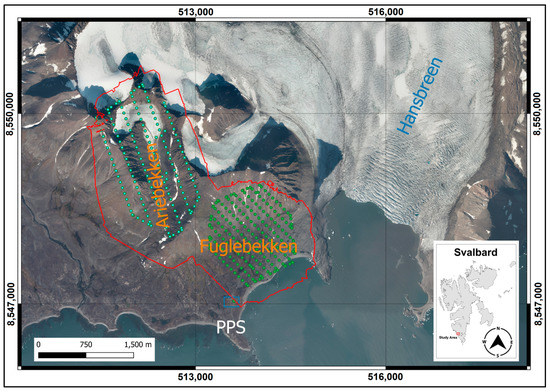
Figure 1.
Location of Fuglebekken and Ariebekken catchments. The red polygon denotes the aerial extent of the orthomosaics. The green points correspond to each aerial photograph taken. Image source: toposvalbard.npolar.no.
Fuglebekken is delineated to the north by the Ariekammen-Fugleberget mountain ridge, and lower parts cover the Fuglebergsletta plain. The eastern part is bounded by the lateral moraine of Hansbreen. Fuglebekken is diverse in terms of land cover and topography. The ground surface is covered by washed rubble sediments, marine terraces built of sea gravel, alluvial cones and bare solid rock, and is partially covered by low tundra vegetation [14].
The Ariebekken catchment is located NW of Fuglebekken and is drained by the small and steep cirque glacier Arie (approx. 0.24 km2). Due to rapid warming, there is an ongoing recession of the glacier. The catchment is surrounded by the mountain massifs of Skoddefjellet, Vesle Skoddefjellet, and Ariekammen. The tall rock walls of these massifs make the slopes difficult to access. The glacier terminates on land, with one outlet stream, Arieelva, that flows through the terminal moraines and drains to the Revelva in Revdalen.
3. Materials and Methods
3.1. Drone Missions over Fuglebekken and Ariebekken
The images were acquired by a DJI Matrice 300 RTK drone (Figure 2) equipped with a Zenmuse P1 camera (45 MP, 35 mm lens). Overall, 167 JPEG format images were acquired from Ariebekken on 25 June 2022 and 204 images from Fuglebekken on 2 July 2022. UAVs allow the surveys to be conducted with minimal risk of impact on fragile flora and fauna, following the regulations and Norwegian legislation. Accordingly, the UAVs were operated by scientists with official UAV Pilot licenses registered at flydrone.no, and the height flight limit was 120 m above the take-off point as following the terrain along steep slopes and couloirs would pose a threat to the colony of little auks and drain the batteries quickly.
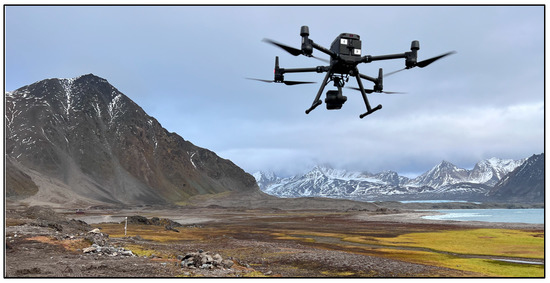
Figure 2.
DJI Matrice 300 RTK Drone equipped with Zenmuse P1 camera during the mission at Fuglebekken catchment.
The missions were planned and executed using the DJI Pilot app in the controller, in accordance with the CAA Norway regulations and procedures (https://luftfartstilsynet.no/en/drones/ accessed on 15 June 2022). To obtain the best resolution of the final products, the flight velocity and overlap were selected based on recommendations for this drone equipped with the P1 camera and the results of our previous experiments. The images were taken automatically to fulfil the chosen criteria, with an overlap of 65%. The survey over Fuglebekken was completed in a single flight, and two flights were conducted over Ariebekken because of faster battery discharge due to high wind velocity. According to the manual, the drone would ideally fly for 55 min without any loads. Due to the attached camera, lower temperature, high winds, and more climbing time, the flying time was reduced to about 35 min for each battery set.
In the Arctic, the use of drones is significantly limited due to weather conditions. Wind speed is the main limitation, and the DJI Matrice 300 RTK drone can safely fly up to 12 m/s during take-off and landing. The other drawbacks result from cloud cover and propeller icing [11]. The flight with the use of an RGB camera should be performed during days with clear sky or relatively low cloud cover when the visible catchment area is maximally large. Only vertical, non-oblique photographs were taken since the Zenmuse P1 camera has higher efficiency and a larger field of view [16]. The pictures were taken with high stability due to the 3-way gimbal system.
Since the weather in the Arctic is highly dynamic, each flight window was carefully chosen so that the drone’s performance was not affected. However, over Fuglebekken, the highest ridges were inaccessible to the survey due to the presence of continuous low clouds that could alter the reflectance of the objects. At Ariebekken, the main challenge was the shadows cast by the high ridges over the valley. The timing was chosen such that a minimal shadow effect was observed in the orthophoto. However, the shadows did not affect the vertical accuracy of the DEM. A total of 9 GCPs and were placed in Fuglebekken and 5 in Ariebekken over the axis of the valley and were collected with a precise dGPS receiver (Leica 1230) with an accuracy ranging from 0.15 cm to 1.4 cm. To assess the quality of the data, 9 additional checkpoints in Fuglebekken were chosen. These checkpoints were the already set scientific instruments visible in the images. For higher accuracy, it is recommended by [17,18] to use a RTK mobile station or more GCPs.
3.2. Data Processing
The digital images acquired during the flight were processed in Agisoft Metashape Professional (https://www.agisoft.com/ accessed on 1 August 2022) software (version 1.8.3). High-resolution DEMs and orthomosaics were created using the SfM method. This photogrammetric technique estimates three-dimensional models from two-dimensional images that have been collected with proper overlap and are coupled with local motion signals. It is widely used in modern photogrammetry, particularly at low levels where UAVs are used and is described elsewhere in more detail [19].
The initial alignment of the images was performed with the “highest” accuracy settings and with adaptive camera model fitting. This allowed the already geo-tagged UAV images and camera characteristics to be automatically selected and adjusted depending on reliability estimations. The aligned photos were then georectified using the GCP coordinates, which enabled more location accuracy. The dense cloud for each catchment was created with “ultra-high” quality with “moderate” depth filtering. In Fuglebekken, a total of 735 million points with an average density of 268 points/m2 and in Ariebekken, a total of 1.1 billion points with an average density of 190 points/m2 were created. The obtained dense cloud was used for DEM generation with the automated pixel size. The orthomosaic was created using the DEM with the mosaic blending mode enabled. The RMS reprojection error of the tie points determined by Agisoft Metashape was 0.184 m and 0.162 m in Fuglebekken and Ariebekken, respectively. The DEM and orthomosaic were exported to raster TIFF format (Figure 3). The DEM and orthomosaic were projected in UTM Zone 33N (EPSG: 32633) for further analysis.
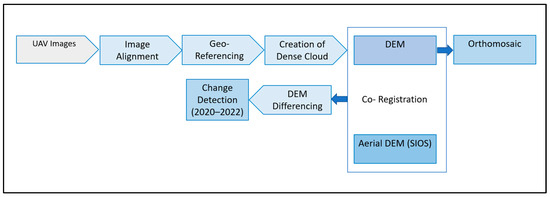
Figure 3.
Flowchart of the data processing and change detection applied in this study.
Another data processing step was to convert the ellipsoidal elevation measured by the DJI Matrice 300 RTK to orthometric elevation, as calculated by Equation (1):
where Ho is the orthometric elevation, He is the ellipsoidal elevation, and N is the geoid elevation above (or below) the ellipsoid.
Ho = He − N
The accuracy was measured in QGIS software by comparing the georeferenced orthomosaic and coordinates taken in the field by dGPS. Although only 9 GCPs in Fugle and 5 in Arie were used, in Fuglebekken, The RMSE of the datasets before georeferencing was 0.17 m. After georeferencing with 9 GCPs, the horizontal RMSE decreased to 0.09 m when compared with the 9 checkpoints in the catchment. The vertical RMSE of the final product was 0.2 m. However, in Ariebekken, no checkpoints were available to assess the overall accuracy of the catchment. The UAV DEMs with a resolution of 0.06 m in Fuglebekken and 0.07 m in Ariebekken were co-registered (Figure 4 and Figure 5) with the SIOS DEM [13] of spatial resolution 0.169 m and then were subjected to change detection analysis. Since each of the DEMs was taken at a similar time of the season with a time difference of 2 years, it allowed for accurate comparison and change detection, concentrating more on the elevation changes.
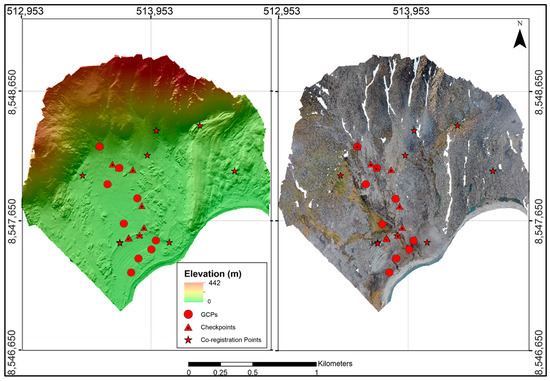
Figure 4.
DEM and orthophotomap of the Fuglebekken catchment. The final resolution post-processing was 0.06 m, and it was geo-rectified by four ground control points (red dots) and co-registration points (red stars).
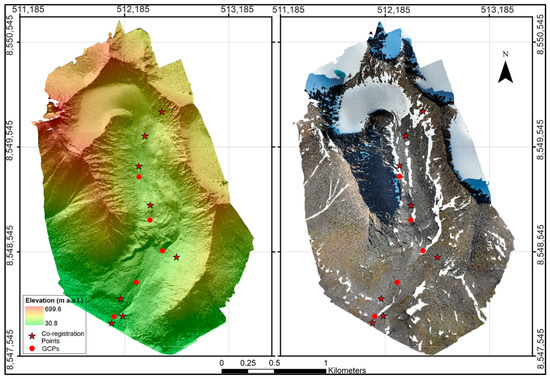
Figure 5.
DEM and orthophotomap of the Ariebekken catchment. The final resolution post-processing was 0.07 m, and it was geo-rectified using five ground control points (red dots) and co-registration points (red stars).
3.3. Derivation of Catchment Parameters
A basic morphometric study was performed in both catchments, which were delineated using ArcMap 10.7.1 with the DEM derived from the drone. The topographical boundary of the catchment was defined with the hydrological gauging station as the convergence point. Areal parameters such as Basin Area, Perimeter, Basin Length, Form Factor, Circulatory Ratio and Elongation Ratio were analysed in this study. Relief aspects such as Basin Relief, Relief Ratio and Average Slope were also analysed [20]. The linear aspects were not analysed, as most of the streams in the catchments are ephemeral. These streams flow only when the ground is frozen and no infiltration takes place or when the ground has been over-saturated so that overland flow exists. The slope and aspect analysis of the three DEMs was performed using the Matlab histogram function.
In addition to the morphometric parameters, stream delineation using the three DEMs was performed to show the differences in the number of derived streams in relation to the spatial resolution of the data. The D8 flow algorithm [21] in ArcMap 10.7.1 was used to calculate flow direction and accumulation. This method estimates the flow of each pixel of the DEM around its 8 neighbours. The presentation of the drainage network is a valuable tool for understanding the water flow patterns in and around the catchment. Using coarser datasets results in further segmentation. In contrast, higher-resolution datasets result in better delineation of flat areas.
Furthermore, change detection analysis was performed by DEM differencing of the drone and aerial DEMs. The drone DEM was co-registered manually by visual interpretation of the orthomosaics. Certain landmarks which were visible in both orthomosaics, such as outcrops, tundra, and boulders, were used, and a total of 19 points were used to co-register the orthomosaics. These same points were used to co-register the corresponding DEM. For more accurate differencing, the drone DEM was resampled to the aerial DEM’s resolution (0.169 m) by the “Nearest Neighbour” resampling technique in ArcMap 10.7.1. The elevation of the aerial DEM was subtracted from the elevation of the drone DEM for the differencing.
4. Results
4.1. DEMs and Orthomosaics
The UAV images acquired on 25 June 2022 over the Arie catchment and on 2 July 2022 over Fuglebekken were processed following the methods presented in the previous section and Figure 3. As a result, DEMs and ortophotomaps for both catchments were derived. During processing, all individual photos were correctly aligned.
Figure 4 presents the outcomes for the Fuglebekken catchment. The obtained georeferenced DEM and orthomosaic of Fuglebekken have a spatial resolution of 0.06 m, with a horizontal RMSE of 0.09 m and vertical 0.2 m. The estimated errors are in the lower limits in comparison with the study by [22]. The “bay” part of the DEM was filtered out as there was noise due to the presence of water waves. The catchment is bounded by the lateral moraine of Hansbreen in the east, the Hornsund fjord to the south, and the Fugleberget-Ariekammen ridge in the north. The coastal part of the catchment is bounded by raised marine terraces, which denotes multiple episodes of isostatic uplifts. The northwestern slopes of Fuglebekken are a nesting colony for little auks (Alle Alle), which is the primary source of nitrogen that fertilises the tundra downstream [23].
The derived DEM and orthophoto map of the Ariebekken catchment are presented in Figure 5. The elevation varies from 30.8 m a.s.l. to almost 700 m a.s.l. The spatial resolution of the derived DEM is 0.07 m with an RMS error of 0.16 m. It can be observed that the upper part of the catchment is glacierised, and the extent of the Arie glacier can be derived. Despite the similar timing of the flights, there are differences in the snow-covered area between the two analysed catchments, which results from higher elevations, different exposure, and topoclimate at Ariebekken compared with Fuglebekken.
4.2. Morphometric Analysis
In order to interpret the hydrogeological properties of a river catchment and analyse its climate, geological conditions, geomorphology, and structural (faults, joints, etc.) elements, morphological examination, and the recognition of fluvial processes are crucial. A summary of the derived parameters is presented in Table 1, and a detailed description of the applied equations and formulas is provided in [20].

Table 1.
Morphometric parameters of Ariebekken and Fuglebekken.
The glaciated Aribekken catchment covers an area of 2.117 km2. The perimeter of the catchment is 8.543 km, and the distance between the most extreme points parallel to the main channel (basin length) is 2.55 km. The form factor (Ff) of Ariebekken is 0.326, which implies that the catchment is “slightly elongated” and indicates that the catchment has a flattened peak flow. The circulatory and elongation ratios of the catchment are 0.364 and 0.644, respectively. These two parameters describe that the basin is elongated parallel to the main channel. As the circulatory ratio increases, the elongation ratio decreases. The values of Rc and Re indicate that the catchment is young with extremely permeable homogenous geologic materials, with high relief, medium to steep slopes and moderate structural control (in this case, the lineaments of the moraine). The difference between the highest and the lowest points (the relief) of the Ariebekken catchment is 633.04 m. The relief ratio is an important parameter to describe the general steepness of the catchment. However, the relief ratio for this catchment is relatively low. This can be attributed to the sudden and extreme drops in elevation (especially in the slopes, moraine and glacial areas), but the average drop in elevation is low. This can be supported by the fact that the average slope of the entire catchment is relatively high (40.92°).
The unglaciated Fuglebekken catchment covers an area of 1.401 km2 and has a perimeter of 6.598 km. The basin length of the catchment from the northernmost point to the flow measuring point is 1.807 km. Given the shape of the catchment, it is no surprise that the form factor (0.429) is higher than that of Ariebekken. This indicates that the catchment is less elongated than Ariebekken and also has a flattened peak flow, but there is a probability that the catchment may experience higher peak flows for short durations. The circulatory ratio of Fuglebekken is 0.241, which implies that the basin is young with permeable homogeneous geologic materials but older than Ariebekken with low structural control. The elongation ratio is 0.738, which indicates that the basin is less elongated (tending towards an oval shape) and eroded, with lower relief and slope than for Ariebekken. For the relief parameters, the relief of Fuglebekken is 508.71 m, and the corresponding relief ratio is 0.28. The higher relief ratio of Fuglebekken can be attributed to the steep slopes in the northern flank of the catchment. Fuglebekken is relatively less steep, with an average slope of 32.07°.
4.3. DEM Comparisons
4.3.1. Physical Comparisons
The DEM obtained from the drone images is compared with the SIOS crewed aircraft mission data acquired on 22 June 2020 [13] and the ArcticDEM (https://www.pgc.umn.edu/data/arcticdem/, accessed on 1 August 2022). These are presented in Figure 6 and Figure 7. ArcticDEM, created on 23 July 2018, was produced using surface extraction from a TIN-based search space minimisation stereo-photogrammetry program [24]. The DEMs were co-registered with each other manually by comparing the orthophoto maps of the SIOS aerial mission and the one acquired by UAV. The spatial resolutions of the aerial mission DEM and ArcticDEM are 0.169 m and 2.0 m, respectively. The DEM acquired by the UAV has a resolution of 0.06 m in Fuglebekken and 0.07 m in Ariebekken. A summary of the properties is provided in Table 2.
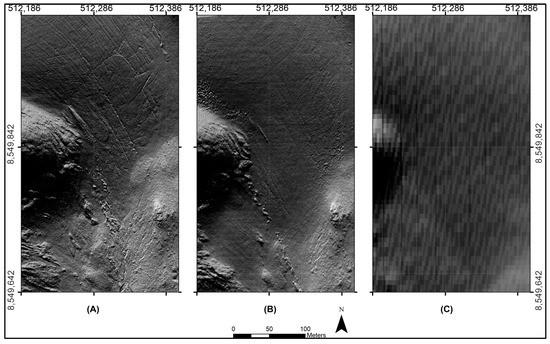
Figure 6.
Comparison of the three DEMs: (A) drone from June 2022, (B) SIOS from July 2020, and (C) ArcticDEM from July 2018 in Ariebreen forefield (note the retreat of the glacier and the exposed outwash plain).
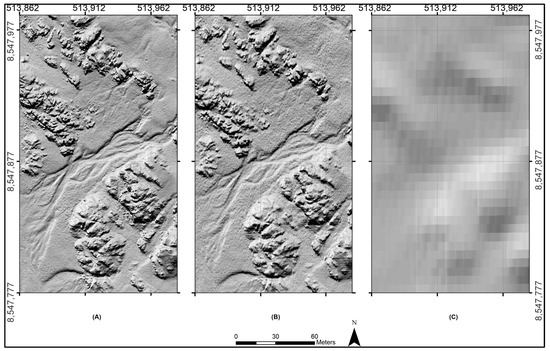
Figure 7.
Comparison of the three different DEMs: (A) drone, (B) SIOS, and (C) Arctic in Fuglebekken (note the differences in smoother texture in the upper right corner on (A,B)).

Table 2.
Comparison of features of different DEMs.
Figure 6 presents the three DEMs with different spatial resolutions in the Ariebreen forefield. The details of the complex topography are visible only on two DEMs: in the highest resolution drone DEM (A), and in the SIOS DEM (B), but not on the Arctic DEM (C). The supraglacial streams and other lineaments, such as crevasses and fractures, are particularly visible in detail on the DEM derived from the drone. Due to the rapid retreat of Ariebreen, the recently exposed outwash plain can also be identified from the drone DEM and the aerial DEM.
Figure 7 presents the three DEMs in the part of the Fuglebekken catchment where the streams are active. Similar to the comparisons in Ariebreen, the ArcticDEM (C) does not show detailed topography of the study area, which would be preferable in a small catchment. The drone DEM (A) appears smoother than the aerial DEM (B), especially on flat surfaces. Due to the finer resolution, the channels appear much more detailed.
4.3.2. Stream Delineations
The hydrophysical characteristics, such as the flow direction, drainage network, and drainage slopes, can be represented using a DEM. The resolution of the elevation data affects the watershed delineation by providing more subbasins (for the same area) when using coarser datasets [25]. The streams were delineated using the directional flow D8 algorithm [21] on the basis of the same flow accumulation values, and the results from Fuglebekken (Figure 8) and Ariebekken (Figure 9) show that the DEM resolution is a vital parameter in this study. These stream networks represent a runoff (flow accumulation) of 500,000 for Fuglebekken and 400,000 for Ariebekken.
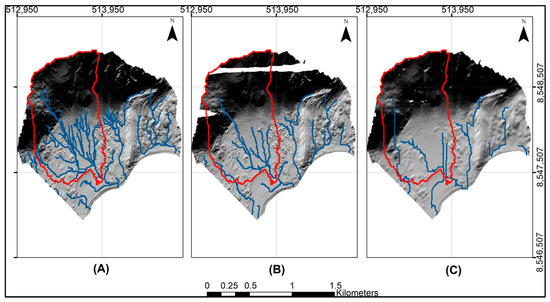
Figure 8.
Delineated stream network in Fuglebekken catchment based on the three different DEMs: drone (A), SIOS (B), and ArcticDEM (C). The red polygon marks the catchment boundary.
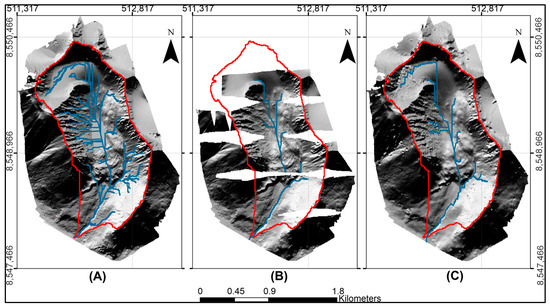
Figure 9.
Delineated stream network in Ariebekken catchment. The drone DEM (A) has delineated many small streams, and although SIOS DEM (B) has better resolution, ArcticDEM (C) has better delineation because of data gaps in SIOS DEM. The red polygon marks the catchment boundary.
When the streamline was delineated using the three DEM resolutions (drone, aerial, and satellite), the overall length of the streamline varied dramatically. With the higher resolution DEMs, the generated stream network has more branches, and minor streams are clearly visible. There is an exception to this statement visible in Figure 9. A comparison of the stream networks derived based on SIOS DEM (B) and ArcticDEM (C) indicated that the latter is more developed despite the smaller resolution of ArcticDEM, which is a result of data gaps in SIOS DEM. In both catchments, delineating all potential streams helped in the identification of potential paths of drainage over the terrain surface.
Small coastal watersheds in the Arctic are characterised by highly variable sizes, morphologies, and dynamics of stream channels. Despite relatively limited width, depth and discharge, the stream channels can be highly dynamic during the ablation season and inter-annually. The discharge of these streams is driven by and highly dependent on not only the precipitation, snow and ice processes but also other factors, such as the underlying permafrost and its degradation, which are not yet completely understood [5,15]. The delineation of the potential water flow is an important factor since it provides information on the water flow patterns, source areas, and stream networks and allows for generating the geometry required for hydrological models. The differences in the potential stream networks with respect to the spatial resolution of the data are visible in Figure 10 and Figure 11.
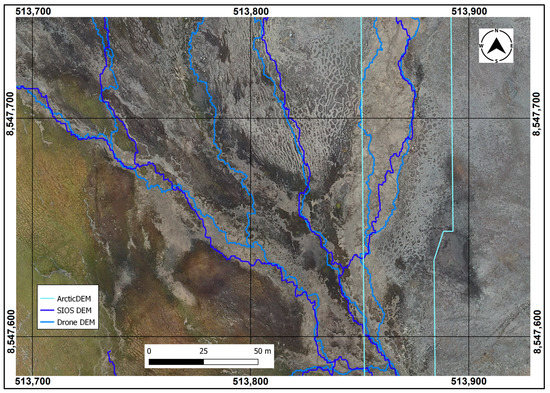
Figure 10.
Comparison of stream delineations using different DEMs in Fuglebekken.
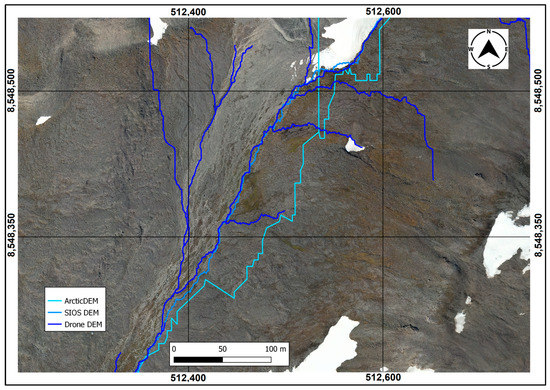
Figure 11.
Comparison of stream delineations using different DEMs in Ariebekken.
4.3.3. Slope and Aspect
Being two of the most vital terrain factors, slope and aspect can be used as a visual representation of the DEM. The slope represents the elevation change rate and must be considered when studying geomorphological characteristics and slope processes. In the case of small catchments which consist of heterogeneous terrains, such as Fuglebekken and Ariebekken, steep slopes are underrepresented. Figure 12 demonstrates the slope distribution in Fuglebekken using the three DEMs. The histogram of the low-resolution ArcticDEM is skewed towards lower values, which makes the image incorrect. In Fuglebekken, the average slope is 32.07°, 31.31°, and 29.79° in the drone DEM, aerial DEM, and ArcticDEM, respectively. In the case of Ariebekken, the average slope is 40.92°, 37.88°, and 38.00° for the drone DEM, aerial DEM, and ArcticDEM, respectively. In the aerial DEM, due to the data gaps in high slope regions, the histogram “sinks” at around 50°–70°, whereas the drone DEM and ArcticDEM show similarities, but the latter is coarser.
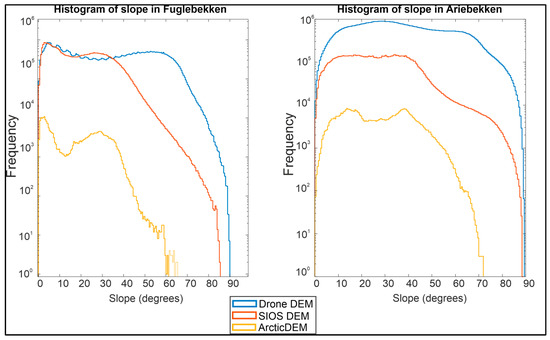
Figure 12.
Slope distribution of three DEMs in Fuglebekken and Ariebekken (note that the lower resolution of DEM causes skewness towards lower values).
By using flow tracking, which makes use of the spatial distribution of aspects, the drainage pattern can be produced. The values of the lower resolution DEM tend to be normalised (Figure 13); hence, the aspect curve is coarser compared with the higher resolution DEMs but shows a symmetrical form.

Figure 13.
A comparison of aspect histograms of three DEMs in Fuglebekken and Ariebekken catchments. Note the symmetrical form in all three DEMs but the difference in the texture of the lines.
4.4. Change Detection
Changes in temperature and precipitation considerably alter ice mass balance and snow conditions, which both influence water flow, and water properties are primary weathering agents for rocks and soils, breaking them down and transporting the ensuing sediments and dissolved solids to the ocean [26]. These processes can, in turn, alter the flow regime. Hence terrain change detection analysis is an important factor in understanding the hydrological cycle.
In the Fuglebekken catchment (Figure 14), the primary sources of elevation difference are the decreases in snow cover depth and extent (especially on the west side of the terminal moraine of Hansbreen) and coastal erosion in Isbjørnhamna in the vicinity of the PPS Hornsund. A downstream channel migration has been observed on the plain. The migrated stream stretch shows a decrease in sinuosity, which implies that there has been a significant influence of runoff. In another separate stretch, there is a significant river incision in the channel bed which may also support the increased runoff hypothesis [15]. Recent geophysical imaging studies [27] indicated that the ground moraine of Hansbreen is ice-cored. The elevation difference (around 0.5–3 m) in this area suggests that the ice cores are melting at a rapid pace.
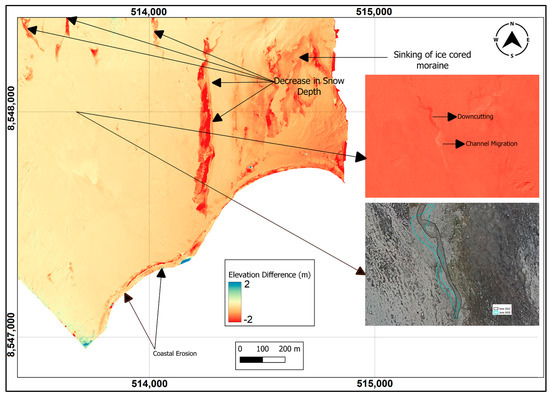
Figure 14.
Estimated differences in elevation between drone DEM from 2022 and SIOS DEM from 2020 in the Fuglebekken catchment. Detected changes include a decrease in snow thickness, the sinking of an ice-cored moraine, river channel migration, and coastal erosion.
In the Ariebekken catchment (Figure 15), the significant change is the negative mass balance of the Ariebreen. The images also reveal changes in the drainage and formation of new supraglacial streams. Lateral channel migration has been observed in the upper parts of Arieelva. The channel migration is of higher magnitude compared with Fugle, as this glacial river has a higher discharge and higher load of sediments. Another major change is the breach in the southernmost ridge of the terminal moraine. The breach is due to the erosion of a new channel (due to increased runoff) and a subsequent fan deposit in front of the breach. Similar to Fuglebekken, there is a significant decrease in the amount of snow in the catchment, but on the southern slopes, there is an increase in snow cover compared with June 2020.
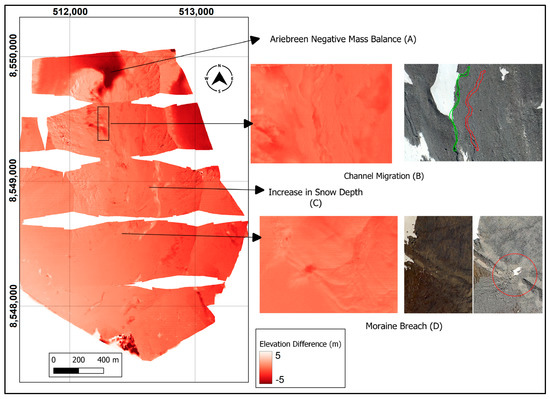
Figure 15.
The differences between drone DEM from 2022 and SIOS DEM from 2020 in the Arie catchment. The arrows indicate the areas with detected changes due to negative geodetic glacier mass balance (A) and river channel migration (B), where the June 2022 extent is shown in green, and the June 2020 extent is shown in red; the increase in snow depth (C), and moraine breach location (D).
5. Discussion
The remote sensing products developed using drones provide vital pieces of information, particularly in remote, harsh or inaccessible areas such as the Arctic. Our results present high accuracy and high-resolution products from a Zenmuse P1 camera fitted on a DJI Matrice 300RTK drone. The data can be used for many research aspects and purposes. We compared elevation datasets of two catchments which are representative of those along the western coasts of Spitsbergen. The comparison was based on the best data previously available (airborne and satellite) with the newly obtained DEM from the UAV survey. Data from repeated missions along the same flight path presented here can be acquired due to smart flight planning. The repeated products can be used for change detection studies, especially in the Arctic, which is undergoing rapid climate warming and has a significant influence on the environment. The UAV photogrammetric algorithm SfM that automatically reconstructed the geometry of the terrain allowed the detection of changes in the periglacial and coastal environments of both glaciated and unglaciated catchments. With the UAV surveys and the planned future missions, the data gaps around Hornsund will be filled with high-resolution orthomosaics and DEMs, which can be of vital importance for scientific studies in this area.
Although only 14 GCPs were used in mapping both catchments, the accuracy of the DEM acquired by the drone is high. The DJI Matrice 300 is equipped with Real Time Kinematic (RTK), which gives sub-centimetre level accuracy. However, due to the remoteness of the study area, the GSM mode of RTK data transmission was not possible. In Fuglebekken, due to the presence of clouds in the upper parts of Fugleberget–Ariekammen ridge, mapping of this area was not possible but will be completed in future missions. Due to the high resolution of the models, we were able to detect even the smallest of changes in and around both catchments, including snow depth differences, a moraine breach, and degradation of subsurface ice cores. In Ariebekken, the presented data can be used as a set for repeated surveys for the geodetic mass balance and surface velocity of Ariebreen, as was performed, for example, for Waldemarbreen by [28].
Digital elevation models of glaciers combining information about the shape and size of a glacier using GIS with mathematical equations that describe its behaviour under different conditions, were studied by [29]. In the past, to measure changes in glacial geometry, DEMs were created by stereo-overlapping of aerial photographs and topo maps. This also allowed identification of the differences between field measurements and DEM-derived mass balance, as described by [30,31]. Recently, the application of DEMs can be accurately showcased by GIS software. The advancement of UAV and camera technologies allows us to gain a better perspective of glacial and periglacial landscapes and the mechanisms underlying their transitions. The authors of [32] evaluated the use of UAV images for high-resolution mapping of ice-wedge polygons. Other studies, such as [18,33], demonstrated that for high-resolution reconstruction, a combined approach involving UAV and GPR survey is an effective method for determining the thickness and internal structure of glaciers and hydrological mass balance. The density distribution of Midtre Lovénbreen active cryoconite habitats has been investigated using ground-based photographs and UAVs [34]. A UAV was used by [35] to capture high-resolution imagery over the lower reaches of the same glacier. This allowed for detailed insights into supra-glacial drainage patterns on its surface. Similar to that study, we have observed the deepening of the supraglacial streams in Ariebreen. Orthomosaics from repeated temporal surveys can be used to determine the velocity of the glacier, as demonstrated by [36,37]. However, the spatial resolution of the elevation model is an important criteria in the evaluation of a catchment [38].
In this paper, we present the multiple scientific implications of various spatial resolutions of remotely sensed data for the same catchments. DEMs from different sources have advantages and disadvantages. UAV data allows the creation of very high-resolution models but is only suitable for small areas and requires the UAV operator to be on the spot. DEMs from satellite images are less accurate but can cover extensive areas (ArcticDEM is one of the examples). Satellite-derived products are feasible for regional studies and larger areas; however, as pointed out by [39], they are highly dependent on various factors (especially in high latitudes), such as continuous cloud cover, sun angle and temporal resolution. Airborne missions may fill this resolution gap but require a lot of planning and precise execution, as described by [40]. Most difficulties and challenges to UAV surveys are also related to meteorological conditions, especially wind speed and precipitation. Due to weather conditions, the flights may have to be postponed, delayed or suspended [8]. With this paper, we provide a baseline for the future extent of glaciological and hydrological monitoring to connect the glacier mass balance, snow cover, and runoff changes in the warming future.
Previous glacial and periglacial geomorphology studies using UAV technology are described by [8,9,11,41]. The publications dealing with UAV studies in Svalbard, in particular, are listed in [42]. Most authors used UAVs for geomorphological mapping and change detection of glacial retreat and evolution of proglacial landforms. There are also publications concerning snow cover, coastal processes, geology, biology, ecology, cultural preservation, and other scientific applications. The authors of [43] used multi-source data and integration in geomorphological maps of the Ny-Ålesund area and the Blomstrandøya. The Billefjorden region of Spitsbergen was surveyed by [44], while the area around Longyearbyen and Adventdalen by [45]. Quantifying the degradation of ice-cored moraine using UAV photogrammetry and other sources was done by [46]. Such examples have demonstrated the use of UAV and SfM photogrammetry for extracting geomorphological changes for appropriate monitoring of the Arctic environment, which has experienced significant changes especially over the last decade [1]. These are particularly visible in the catchments transitioning from glacial to non-glacial conditions [41]. This implies intense geomorphic, hydrological, and ecological dynamics of key terrestrial components. To better understand the causes of changes and their consequences, it is important to identify and quantify them. Rates of change in proglacial systems were determined across the studied catchments, and with the acquired DEM, we were able to observe morphological changes such as the flattening of moraines, their breaches and gully deepening in centimetre scale. The elevation changes in the Hansbreen moraine were observed to be 0.5 m–3.0 m in two years. The authors of [13] reported that the annual erosion of these moraines amounted to 0.7 m due to the melting of ice cores and erosion along the shoreline. An investigation of the Austre Lovénbreen frontal moraines [46] revealed a surface lowering of −1.75 ± 0.89 m over an 11-year period.
This study compares elevation datasets of two High Arctic catchments based on the best data previously available (airborne and satellite) with the newly obtained DEM from a UAV survey. It presents the workflow in such a manner that it can be repeated and evaluated by future studies as recommended by [47]. The main sources of error in aerial mapping include lack of usage of GCPs or their non-optimised layout. There can also be errors pertaining to the GPS measurements of the GCPs, which can be avoided by using high-accuracy dGPS. Regarding the flight itself, the velocity and the overlap should be selected so that the images are not blurry or indistinct. Images with sufficient boundary coverage and overlap result in sharp and complete orthomosaics. During the survey, especially in the regions surrounded by high mountains, a manual control takeover may be necessary in the event of an unexpected onboard GNSS or any other system failure. This will force the survey to be stopped and may cause stitching problems during processing. As each flight survey contains hundreds of images, the processing should be performed on sufficiently powerful computers. More powerful computers allow for processing these images with high accuracy and alignment. For change detection analysis, care should be taken while selecting the co-registration points, as this may have an effect on the estimated differences.
Automated drone mapping of an inaccessible area of 7.04 km2 in around two hours demonstrated the high feasibility of using drones in polar studies. The acquisition of the images enables the provision of a well-resolved, high-end quality remote sensing product with a wide range of applications. The processing of these images requires high computational power and can be time-consuming. With a spatial resolution of 0.06 m for Fuglebekken and 0.07 m for Ariebekken, the orthomosaics and DEM can be accessed by the broad scientific community and can be visualised accordingly. However, for comparison purposes of any future data sources and products, we recommend to co-register the acquired DEM with the other data models. This would increase the accuracy of the products required for any long-term change detection studies needed in this fragile environment.
6. Conclusions
In this paper, we integrated the use of high-resolution aerial stereo images and the SfM technique to create Digital Elevation Models (DEMs). Such an approach has shown to be superior to previous surveys conducted in SW Spitsbergen and allowed sub-decimetre resolution of two High Arctic catchments. With this UAV-derived DEM, we have filled a data gap as only satellite and aeroplane-based products were previously available for this area. Acquisition of DEMs using UAVs can be included in detailed studies on a range of environments. The DEMs can be used in a variety of applications, including geomorphology, hydrology, glaciology, ecology etc., and can be useful in change detection analysis when the time frame cannot be met by satellite or aeroplane-based sensors. We also highlight the use of drone-derived DEM for applications such as catchment and stream network delineation, morphometric characterisation, and detection of changes. The spatial resolution influences the obtained land surface parameters. The data provided in this paper allows for the investigation of landform development on a centimetre scale. The obtained resolution enables the detection of even small changes in large-scale processes, such as geomorphological activity, glacier, moraine and river channel dynamics, slope creeping, active layer detachments, etc. Our future plans include multi-temporal surveys with other cameras, such as thermal and multispectral, with a higher number of GCPs and an RTK base station, that will allow detailed quantification of snow and ice melt, channel migration, and other transformations of Arctic landforms due to climate change.
The procured data, along with the planned future missions, will be made available as open-source data and can be used for many applications by the broad scientific community. The choice of UAV is also motivated by the ability to produce high-resolution products of aerial imagery at lower cost and safety compared with crewed aircraft. The derived DEMs and orthophotomaps of Fuglebekken and Ariebekken catchments are available at IG PAS Data Portal (geodata.igf.edu.pl/Hornsund_DEM/).
Author Contributions
Conceptualization, A.B.A., T.W. and M.O.; methodology, A.B.A., T.W., M.O. and N.H.; data curation, A.B.A. and T.W.; writing—original draft preparation, A.B.A., T.W., M.O. and N.H.; writing—review and editing, A.B.A., T.W., M.O. and N.H. All authors have read and agreed to the published version of the manuscript.
Funding
The study was supported by the Polish National Science Centre (grant no. 2020/38/E/ST10/00139) and partially by a subsidy from the Polish Ministry of Science and Higher Education for the Institute of Geophysics, Polish Academy of Sciences.
Data Availability Statement
Publicly available datasets were analysed in this study. This data can be found here: Orthomosaic of Fuglebekken: https://geodata.igf.edu.pl/Hornsund_DEM/Orthomosaic%20of%20Fuglebekken.tif; Digital Elevation Model of Fuglebekken: https://geodata.igf.edu.pl/Hornsund_DEM/Digital%20Elevation%20Model%20of%20Fuglebekken.tif; Orthomosaic of Ariebekken: https://geodata.igf.edu.pl/Hornsund_DEM/Orthomosaic%20of%20Ariebekken.tif; Digital Elevation Model of Ariebekken: https://geodata.igf.edu.pl/Hornsund_DEM/Digital%20Elevation%20Model%20of%20Ariebekken.tif.
Acknowledgments
The authors would like to acknowledge the reviewers for their comments and suggestions, which helped in improving the quality of the manuscript.
Conflicts of Interest
The authors declare no conflict of interest.
References
- Wawrzyniak, T.; Osuch, M. A 40-year High Arctic climatological dataset of the Polish Polar Station Hornsund (SW Spitsbergen, Svalbard). Earth Syst. Sci. Data 2020, 12, 805–815. [Google Scholar] [CrossRef]
- Meredith, M.; Sommerkorn, M.; Cassotta, S.; Derksen, C.; Ekaykin, A.; Hollowed, A.; Kofinas, G.; Mackintosh, A.; Melbourne-Thomas, J.; Muelbert, M.M.C.; et al. (Eds.) Chapter 3—Polar Regions; Cambridge University Press: Cambridge, UK; New York, NY, USA, 2019; pp. 203–320. [Google Scholar] [CrossRef]
- Masson-Delmotte, V.; Zhai, P.; Pirani, A.; Connors, S.L.; Péan, C.; Berger, S.; Caud, N.; Chen, Y.; Goldfarb, L.; Gomis, M.I.; et al. (Eds.) IPCC: Climate Change 2021: The Physical Science Basis. Contribution of Working Group I to the Sixth Assessment Report of the Intergovernmental Panel on Climate Change; Cambridge University Press: Cambridge, UK; New York, NY, USA, 2021. [Google Scholar] [CrossRef]
- Matti, B.; Dahlke, H.E.; Lyon, S.W. On the Variability of Cold Region Flooding. J. Hydrol. 2016, 534, 669–679. [Google Scholar] [CrossRef]
- Osuch, M.; Wawrzyniak, T.; Łepkowska, E. Changes in the Flow Regime of High Arctic Catchments with Different Stages of Glaciation, SW Spitsbergen. Sci. Total Environ. 2022, 817, 152924. [Google Scholar] [CrossRef]
- Vaze, J.; Teng, J.; Spencer, G. Impact of DEM accuracy and resolution on topographic indices. Environ. Model. Softw. 2010, 25, 1086–1098. [Google Scholar] [CrossRef]
- Błaszczyk, M.; Ignatiuk, D.; Grabiec, M.; Kolondra, L.; Laska, M.; Decaux, L.; Jania, J.; Berthier, E.; Luks, B.; Barzycka, B. Quality Assessment and Glaciological Applications of Digital Elevation Models Derived from Space-Borne and Aerial Images over Two Tidewater Glaciers of Southern Spitsbergen. Remote Sens. 2019, 11, 1121. [Google Scholar] [CrossRef]
- Śledź, S.; Ewertowski, M.W.; Piekarczyk, J. Applications of unmanned aerial vehicle (UAV) surveys and Structure from Motion photogrammetry in glacial and periglacial geomorphology. Geomorphology 2021, 378, 107620. [Google Scholar] [CrossRef]
- Hann, R.; Altstädter, B.; Betlem, P.; Deja, K.; Dragańska-Deja, K.; Ewertowski, M.; Hartvich, F.; Jonassen, M.; Lampert, A.; Laska, M.; et al. Scientific Applications of Unmanned Vehicles in Svalbard (UAV Svalbard). In SESS report 2020—The State of Environmental Science in Svalbard—An annual report. Svalbard Integr. Arct. Earth Obs. Syst. 2021, 3, 78–103. [Google Scholar] [CrossRef]
- Gaffey, C.; Bhardwaj, A. Applications of unmanned aerial vehicles in cryosphere: Latest advances and prospects. Remote Sens. 2020, 12, 948. [Google Scholar] [CrossRef]
- Hann, R.; Betlem, P.; Deja, K.; Hartvich, F.; Jonassen, M.; Lampert, A.; Laska, M.; Sobota, I.; Storvold, R.; Zagórski, P. Update to Scientific Applications of Unmanned Vehicles in Svalbard (UAV Svalbard Update). In Svalbard Integrated Arctic Earth Observing System Place: Longyearbyen ISBN Book title: SESS report 2021—The State of Environmental Science in Svalbard—An annual report. Svalbard Integr. Arct. Earth Obs. Syst. 2022, 4, 74–86. [Google Scholar] [CrossRef]
- Claire, P.; Paul, M.; Ian, H.; Myoung-Jon, N.; Brian, B.; Kenneth, P.; Scott, K.; Matthew, S.; Judith, G.; Karen, T.; et al. “ArcticDEM, Version 3”, Harvard Dataverse, V1. 2018. Available online: https://dataverse.harvard.edu/dataset.xhtml?persistentId=doi:10.7910/DVN/OHHUKH (accessed on 1 August 2022).
- Błaszczyk, M.; Laska, M.; Sivertsen, A.; Jawak, S.D. Combined Use of Aerial Photogrammetry and Terrestrial Laser Scanning for Detecting Geomorphological Changes in Hornsund, Svalbard. Remote Sens. 2022, 14, 601. [Google Scholar] [CrossRef]
- Wawrzyniak, T.; Majerska, M.; Osuch, M. Hydrometeorological Dataset (2014–2019) from the High Arctic Unglaciated Catchment Fuglebekken (Svalbard). Hydrol. Process. 2021, 35, e13974. [Google Scholar] [CrossRef]
- Osuch, M.; Wawrzyniak, T.; Majerska, M. Changes in hydrological regime in High Arctic non-glaciated catchment in 1979–2020 using a multimodel approach. Adv. Clim. Chang. Res. 2022, 13, 517–530. [Google Scholar] [CrossRef]
- Zenmuse P1—Full-Frame Aerial Surveying. DJI. (n.d.). Available online: https://www.dji.com/pl/zenmuse-p1 (accessed on 15 November 2022).
- Sanz-Ablanedo, E.; Chandler, J.H.; Rodríguez-Pérez, J.R.; Ordóñez, C. Accuracy of unmanned aerial vehicle (UAV) and SfM photogrammetry survey as a function of the number and location of ground control points used. Remote Sens. 2018, 10, 1606. [Google Scholar] [CrossRef]
- Karušs, J.; Lamsters, K.; Ješkins, J.; Sobota, I.; Džeriņš, P. UAV and GPR Data Integration in Glacier Geometry Reconstruction: A Case Study from Irenebreen, Svalbard. Remote Sens. 2022, 14, 456. [Google Scholar] [CrossRef]
- Küng, O.; Strecha, C.; Beyeler, A.; Zufferey, J.-C.; Floreano, D.; Fua, P.; Gervaix, F. The accuracy of automatic photogrammetric techniques on ultra-light UAV imagery. In Proceedings of the UAV-g 2011—Unmanned Aerial Vehicle in Geomatics, Zürich, Switzerland, 14–16 September 2011. [Google Scholar] [CrossRef]
- López-Ramos, A.; Medrano-Barboza, J.P.; Martínez-Acosta, L.; Acuña, G.J.; Remolina López, J.F.; López-Lambraño, A.A. Assessment of Morphometric Parameters as the Basis for Hydrological Inferences in Water Resource Management: A Case Study from the Sinú River Basin in Colombia. ISPRS Int. J. Geo-Inf. 2022, 11, 459. [Google Scholar] [CrossRef]
- Boonklong, O.; Jaroensutasinee, M.; Jaroensutasinee, K. Computation of D8 Flow Line at Ron Phibun Area, Nakhon Si Thammarat, Thailand. World Acad. Sci. Eng. Technol. 2007, 33, 1–4. [Google Scholar]
- Jiménez-Jiménez, S.I.; Ojeda-Bustamante, W.; Marcial-Pablo, M.D.J.; Enciso, J. Digital terrain models generated with low-cost UAV photogrammetry: Methodology and accuracy. ISPRS Int. J. Geo-Inf. 2021, 10, 285. [Google Scholar] [CrossRef]
- Skrzypek, G.; Wojtuń, B.; Richter, D.; Jakubas, D.; Wojczulanis-Jakubas, K.; Samecka, A. Diversification of Nitrogen Sources in Various Tundra Vegetation Types in the High Arctic. PLoS ONE 2015, 10, e0136536. [Google Scholar] [CrossRef]
- Noh, M.J.; Howat, I.M. The Surface Extraction from TIN Based Search-Space Minimization (SETSM) Algorithm. ISPRS J. Photogramm. Remote Sens. 2017, 129, 55–76. [Google Scholar] [CrossRef]
- Buakhao, W.; Kangrang, A. DEM resolution impact on the estimation of the physical characteristics of watersheds by using SWAT. Adv. Civ. Eng. 2016, 2016, 8180158. [Google Scholar] [CrossRef]
- Adakudlu, M.; Andersen, J.; Bakke, J.; Beldring, S.; Benestad, R.; Bilt, W.V.D.; Bogen, J.; Borstad, C.; Breili, K.; Breivik, Ø.; et al. Climate in Svalbard 2100—A Knowledge Base for Climate Adaptation. 2019. Available online: https://repository.oceanbestpractices.org/handle/11329/1382 (accessed on 5 September 2022).
- Marciniak, A.; Osuch, M.; Wawrzyniak, T.; Owoc, B.; Dobiński, W.; Glazer, M.; Majdański, M. Multi-method geophysical mapping of ground properties and periglacial geomorphology in Hans Glacier forefield, SW Spitsbergen. Pol. Polar Res. 2022, 43/2, 101–123. [Google Scholar] [CrossRef]
- Lamsters, K.; Ješkins, J.; Sobota, I.; Karušs, J.; Džeriņš, P. Surface Characteristics, Elevation Change, and Velocity of High-Arctic Valley Glacier from Repeated High-Resolution UAV Photogrammetry. Remote Sens. 2022, 14, 1029. [Google Scholar] [CrossRef]
- Etzelmüller, B.; Björnsson, H. Map analysis techniques for glaciological applications. Int. J. Geogr. Inf. Sci. 2022, 14, 567–581. [Google Scholar] [CrossRef]
- Rippin, D.; Willis, I.; Arnold, N.; Hodson, A.; Moore, J.; Kohler, J.; Björnsson, H. Changes in geometry and subglacial drainage of Midre Lovénbreen, Svalbard, determined from digital elevation models. Earth Surf. Process. Landf. J. Br. Geomorphol. Res. Group 2003, 28, 273–298. [Google Scholar] [CrossRef]
- Pope, A.; Murray, T.; Luckman, A. DEM quality assessment for quantification of glacier surface change. Ann. Glaciol. 2007, 46, 189–194. [Google Scholar] [CrossRef]
- Lousada, M.; Pina, P.; Vieira, G.; Bandeira, L.; Mora, C. Evaluation of the use of very high resolution aerial imagery for accurate ice-wedge polygon mapping (Adventdalen, Svalbard). Sci. Total Environ. 2018, 615, 1574–1583. [Google Scholar] [CrossRef]
- Karušs, J.; Lamsters, K.; Sobota, I.; Ješkins, J.; Džeriņš, P.; Hodson, A. Drainage system and thermal structure of a High Arctic polythermal glacier: Waldemarbreen, western Svalbard. J. Glaciol. 2021, 68, 591–604. [Google Scholar] [CrossRef]
- Hodson, A.; Anesio, A.M.; Ng, F.; Watson, R.; Quirk, J.; Irvine-Fynn, T.; Dye, A.; Clark, C.; McCloy, P.; Kohler, J.; et al. A glacier respires: Quantifying the distribution and respiration CO2 flux of cryoconite across an entire Arctic supraglacial ecosystem. J. Geophys. Res. Biogeosciences 2007, 112, 1–9. [Google Scholar] [CrossRef]
- Rippin, D.M.; Pomfret, A.; King, N. High resolution mapping of supra-glacial drainage pathways reveals link between micro-channel drainage density, surface roughness and surface reflectance. Earth Surf. Process. Landf. 2015, 40, 1279–1290. [Google Scholar] [CrossRef]
- Whitehead, K.; Moorman, B.J.; Hugenholtz, C.H. Brief Communication: Low-cost, on-demand aerial photogrammetry for glaciological measurement. Cryosphere 2013, 7, 1879–1884. [Google Scholar] [CrossRef]
- Kraaijenbrink, P.; Meijer, S.W.; Shea, J.M.; Pellicciotti, F.; De Jong, S.M.; Immerzeel, W.W. Seasonal surface velocities of a Himalayan glacier derived by automated correlation of unmanned aerial vehicle imagery. Ann. Glaciol. 2016, 57, 103–113. [Google Scholar] [CrossRef]
- Parizi, E.; Khojeh, S.; Hosseini, S.M.; Moghadam, Y.J. Application of Unmanned Aerial Vehicle DEM in flood modeling and comparison with global DEMs: Case study of Atrak River Basin, Iran. J. Environ. Manag. 2022, 317, 115492. [Google Scholar] [CrossRef]
- Gaffey, C.B.; Bhardwaj, A.; Frey, K.E.; Estes, L. Polar and Cryospheric Remote Sensing Using sUAS. In sUAS Applications in Geography. Geotechnologies and the Environment; Konsoer, K., Leitner, M., Lewis, Q., Eds.; Springer: Cham, Switzerland, 2022; Volume 24. [Google Scholar] [CrossRef]
- Ewertowski, M.W.; Tomczyk, A.M.; Evans, D.J.A.; Roberts, D.H.; Ewertowski, W. Operational Framework for Rapid, Very-high Resolution Mapping of Glacial Geomorphology Using Low-cost Unmanned Aerial Vehicles and Structure-from-Motion Approach. Remote Sens. 2019, 11, 65. [Google Scholar] [CrossRef]
- Carrivick, J.L.; Heckmann, T. Short-term geomorphological evolution of proglacial systems. Geomorphology 2017, 287, 3–28. [Google Scholar] [CrossRef]
- SESS UAV Database. Database of Scientific Applications of Unmanned Vehicles in Svalbard; Version 1; Zenodo Dataset: Meyrin, Switzerland, 2021. [Google Scholar] [CrossRef]
- Berthling, I.; Berti, C.; Mancinelli, V.; Stendardi, L.; Piacentini, T.; Miccadei, E. Analysis of the paraglacial landscape in the Ny-Ålesund area and Blomstrandøya (Kongsfjorden, Svalbard, Norway). J. Maps 2020, 16, 818–833. [Google Scholar] [CrossRef]
- Ewertowski, M.W.; Tomczyk, A.M. Reactivation of temporarily stabilized ice-cored moraines in front of polythermal glaciers: Gravitational mass movements as the most important geomorphological agents for the redistribution of sediments (a case study from Ebbabreen and Ragnarbreen, Svalbard). Geomorphology 2020, 350, 106952. [Google Scholar] [CrossRef]
- De Haas, T.; Kleinhans, M.G.; Carbonneau, P.E.; Rubensdotter, L.; Hauber, E. Surface morphology of fans in the high-Arctic periglacial environment of Svalbard: Controls and processes. Earth-Sci. Rev. 2015, 146, 163–182. [Google Scholar] [CrossRef]
- Tonkin, T.N.; Midgley, N.G.; Cook, S.J.; Graham, D.J. Ice-cored moraine degradation mapped and quantified using an unmanned aerial vehicle: A case study from a polythermal glacier in Svalbard. Geomorphology 2016, 258, 1–10. [Google Scholar] [CrossRef]
- James, M.R.; Chandler, J.H.; Eltner, A.; Fraser, C.; Miller, P.E.; Mills, J.P.; Noble, T.; Robson, S.; Lane, S.N. Guidelines on the use of structure-from-motion photogrammetry in geomorphic research. Earth Surf. Process. Landf. 2019, 44, 2081–2084. [Google Scholar] [CrossRef]
Disclaimer/Publisher’s Note: The statements, opinions and data contained in all publications are solely those of the individual author(s) and contributor(s) and not of MDPI and/or the editor(s). MDPI and/or the editor(s) disclaim responsibility for any injury to people or property resulting from any ideas, methods, instructions or products referred to in the content. |
© 2023 by the authors. Licensee MDPI, Basel, Switzerland. This article is an open access article distributed under the terms and conditions of the Creative Commons Attribution (CC BY) license (https://creativecommons.org/licenses/by/4.0/).